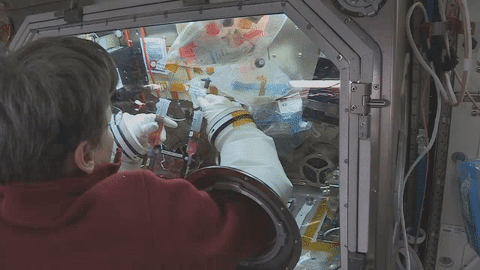ISS - International Space Station logo.
Sept. 27, 2018
Research on the International Space Station could help scientists speed recovery in the hearts of astronauts in space as well as people on Earth. Spaceflight induces a range of changes in human heart cells. Understanding these effects could lead to therapies to treat heart disease and repair cardiac tissue on Earth, as well as therapies to maintain astronaut cardiac health during long-duration spaceflight.
Researchers cultured human stem cells, or cardiovascular progenitor cells (CPCs), in the microgravity environment of the space station. The team reported the findings from the Cardiac Stem Cells investigation in a paper published in the journal npj Microgravity.
Animation above: NASA astronaut Peggy Whitson conducts a medium change within the Microgravity Science Glovebox (MSG) as a part of the Cardiac Stem Cells investigation. Animation Credit: NASA.
Stem cells are able to continually divide to produce more of the same cells, and also can differentiate into specialized cell types. Neonatal stem cells proliferate more rapidly and differentiate into more different kinds of cells than do other stem cells. In some organs, such as bone marrow, stem cells regularly divide to repair and replace worn out or damaged tissues. This allows stem cells to repair and replace worn out or damaged tissues. While cardiovascular stem cells reside in the human heart, neonatal stem cells are able to proliferate more effectively than the same cells in the adult heart. This means neonatal hearts are more capable at repairing tissue damage than adult hearts.
“While we know spaceflight affects cardiac function and structure, the biological basis for this is not clearly understood,” said principal investigator Mary Kearns-Jonker, a researcher in the Department of Pathology and Human Anatomy at Loma Linda University School of Medicine in California. The study looked at the factors that govern stem cell activity, including physical and molecular changes, to clarify their role and how microgravity affects that role.
Image above: Cardiac Progenitor Cells (CPCs) cultured for the Cardiac Stem Cell investigation aboard the International Space Station. Image Credit: Loma Linda University.
Kearns-Jonker and colleagues isolated CPCs from the neonatal and adult human heart and examined the influence of microgravity on a variety of characteristics, including migration (cell movement within organs), proliferation (how many cells a CPC produced), and differentiation (what other types of cells a CPC generated). The researchers cultured clonal, or genetically identical, neonatal and adult cells in space and on the ground for the study.
In the npj Microgravity paper, the investigators report that spaceflight affected the developmental status, proliferative potential, and migratory ability of CPCs. Changes in gene expression associated with stem cell characteristics and differentiation also were noted, with response to microgravity differing between neonatal and adult cells. Some similarities also were identified.
“CPCs from both the neonatal and adult population expressed higher levels of factors that enhance migration and increase proliferation,” Kearns-Jonker said. “But the effects were more pronounced in the neonatal cells.”
Image above: Neonatal cardiac stem cells were seeded at identical concentration in Biocells cultured on the ground (left panel) and the International Space Station (right panel) for 30 days. After live cell return from the ISS, cell counts obtained following culture in space versus culture on the ground for the same length of time were compared. The graph indicates that cardiac stem cell clones proliferate more quickly when cultured in space. Image Credit: Loma Linda University.
Changes in migration, proliferation and gene expression induced by spaceflight are important for optimizing CPCs for cardiovascular repair. Enhanced migration, for example, could enable these cells to move to the site of heart tissue damage, and enhanced proliferation would make more cells available to repair the damage.
“We find this very promising,” Kearns-Jonker said. Better understanding of the molecular mechanisms that influence cardiac stem cell function supports design of therapies to treat heart disease and repair cardiac tissue on Earth. Understanding how microgravity affects these stem cells contributes to the goal of developing therapies to maintain astronaut cardiac health during long spaceflight and reverse heart muscle loss once astronauts return to Earth.
The researchers also published results from the investigation in the journal Stem Cells and Development.
International Space Station (ISS). Image Credit: NASA/STS-130
The next step is to test the cells in microgravity in model organisms, such as mice, to further understand what makes them functional in tissue repair. “Things we’ve learned from these cells in the spaceflight environment help get us there,” Kearns-Jonker said.
Thanks to research in space, scientists are that much closer to mending broken hearts.
This investigation was sponsored by the ISS National Lab, which is managed by the Center for the Advancement of Science in Space (CASIS).
Related links:
Journal npj Microgravity: http://www.nature.com/articles/s41526-018-0048-x
Journal Stem Cells and Development: https://www.liebertpub.com/doi/10.1089/scd.2017.0263
Cardiac Stem Cells: https://www.nasa.gov/mission_pages/station/research/experiments/explorer/Investigation.html?#id=7464
Model organisms: https://blogs.nasa.gov/ISS_Science_Blog/2013/11/13/model-organisms-shining-examples-for-simple-effective-biology-research/
Center for the Advancement of Science in Space (CASIS): https://www.iss-casis.org/
Space Station Research and Technology: https://www.nasa.gov/mission_pages/station/research/index.html
International Space Station (ISS): https://www.nasa.gov/mission_pages/station/main/index.html
Images (mentioned), Animation (mentioned), Text, Credits: NASA/Michael Johnson/JSC/International Space Station Program Science Office/Melissa Gaskill.
Greetings, Orbiter.ch





